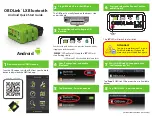
SECTION 4 - MAINTENANCE
4-3
BELT AND CHAIN MAINTENANCE
V-BELT CARE AND MAINTENANCE
Drive belts transmit power by friction and a wedging
action against the sheaves. Belts and sheaves are
therefore subject to wear and should be checked
daily. Wear is normal if it is even along both sides of
the belt for its entire length and even along the inside
circumference of the sheave.
IMPORTANT:
Check all V-belts every five hours of
operation for the first 50 hours of operation. Adjust for
initial stretch.
Whenever unusual belt or sheave wear is noticed or
a belt breaks, immediately check for the cause. The
cause is usually too little belt tension, a shock load,
or a pluggage.
NOTE:
Only a very few failures are caused by a
defective belt.
The sides of the drive belts should always have a dull
appearance. A belt that has shiny sides has been
slipping and will eventually have to be replaced.
Continued operation will cause more slippage.
Stress cracks will then occur along the belt due to the
excessive heat buildup. The use of “belt grip”
products is not recommended. These products
generally only give very temporary gripping action
while causing further deterioration of the belt.
Over tightening the belt can cause it to snap in half
if a sudden heavy load is applied to the drive.
If a driven sheave stops due to a plugging problem,
the drive sheave may burn a section of the belt. The
drive may then vibrate because of a narrow burned
spot. Replace the belt immediately to prevent other
problems.
Vibration can also be caused by a lumpy V-belt.
Check belts for swells and lumps. Use only factory
recommended V-belts of the proper length.
NOTE:
A slight raveling or peeling of the belt at the
lap does not indicate premature failure. Cut off the
raveling if the covering peels at the lap. Check for the
cause of unusual belt wear before replacing the belt.
BELT INSTALLATION
IMPORTANT:
Never pry the belt over the edge of the
sheave, as this may rupture belt cords and shorten
belt life. Place the belt in the sheave groove by hand.
V-BELT CLEANING
Clean belts by wiping them with a clean cloth.
Immediately wipe off any spilled oil or grease. Do not
use solvents because they will soften the belt.
SHEAVE DEFECTS
Examine sheaves for bent or chipped sidewalls, and
check for excessive sidewall wear. Damaged
sheaves cause rapid belt wear. A bent belt sheave
reduces the gripping power of the belt. Immediately
replace sheaves having any of these defects.
DIRTY SHEAVES
Check to be sure dirt has not lodged and packed in
the sheave V-grooves. Excessive vibration may be
caused by dirt collecting inside the sheaves. Remove
dirt from the sheaves.
Summary of Contents for Haybine 499
Page 1: ... 5HSODFHV OO 3UHYLRXV VVXHV ...
Page 2: ... 1 PHULFD ...
Page 28: ...SECTION 1 GENERAL INFORMATION 1 18 ...
Page 50: ...SECTION 2 OPERATION 2 22 ...
Page 60: ...SECTION 3 LUBRICATION 3 10 ...
Page 71: ...SECTION 4 MAINTENANCE 4 11 9 Tighten bolts 1 and nuts 2 10004725 1 1 2 12 ...
Page 110: ...SECTION 4 MAINTENANCE 4 50 ...
Page 114: ...SECTION 5 TROUBLESHOOTING 5 4 ...
Page 122: ...SECTION 7 SPECIFICATIONS 7 4 ...
Page 126: ...7 8 ...
Page 128: ...7 10 ...
















































